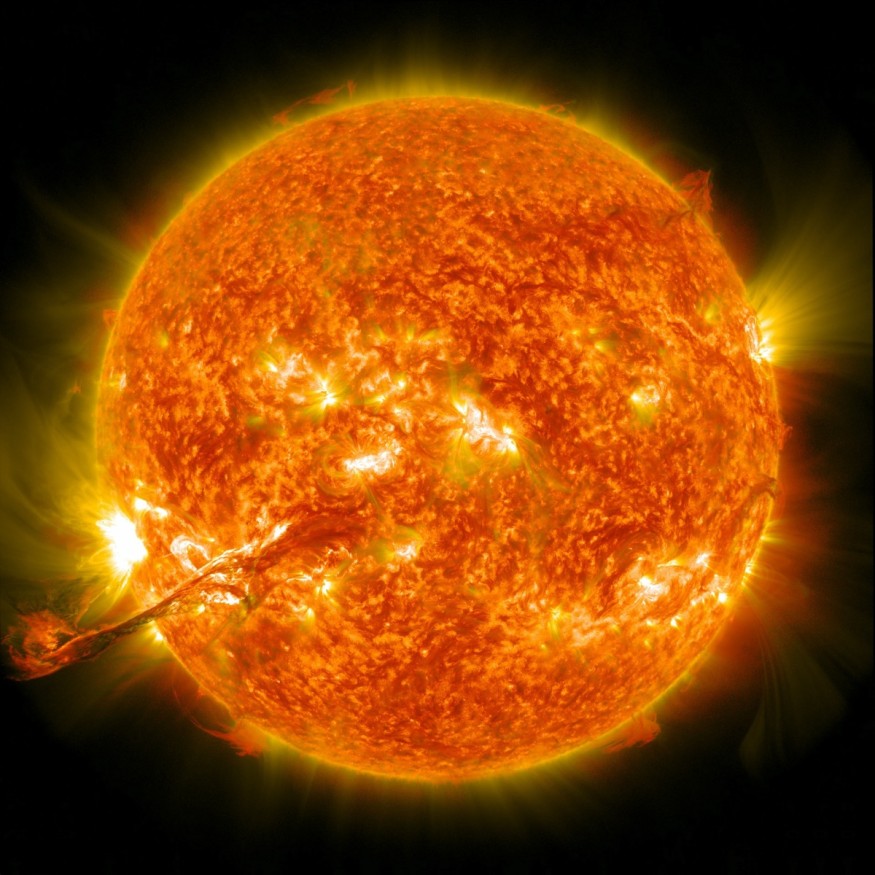Earth is at risk of "radiation storms" and "cannibal" Sun eruptions due to solar storms. Major interruptions might befall the aircraft as a "cannibal" solar flare hurtles toward the US.

Cannibal Coronal Mass Ejection
According to space-weather researchers, a cannibal coronal mass ejection (CME) may be headed for Earth. The Sun releases a cloud of charged particles and electromagnetic disturbances, known as a CME, one of the strongest types of solar storms. The fastest flares may overtake and gobble up the slower ones to generate a bigger one known as a cannibal CME when many solar outbursts are emitted in rapid succession and in the same direction.
The Sun released a black plasma explosion on Sunday that sent a CME directly towards Earth. A second magnetic filament exploded the following day, launching a second CME immediately behind it. Both CMEs will collide with Earth on August 18, according to the National Oceanic and Atmospheric Administration forecast models from the Space Weather Prediction Center (SWPC).
This might be a "Cannibal CME" event, according to experts at spaceweather.com. In other words, the first CME and the second CME may merge and surpass one another.
Intense Solar Storms

Strong geomagnetic storms can be caused by the compressed plasma and entangled magnetic fields seen in cannibal CMEs. In this instance, NOAA forecasters anticipate geomagnetic storms of the G1 (mild) to G2 (moderate) classes. When these storms occur, naked-eye auroras can be seen as far south as New York and Idaho in the USA (geomagnetic latitude 55 degrees).
The Sun is reaching the solar maximum, the culmination of its 11-year cycle. More sunspots are developing on the Sun's surface during this period, which increases the frequency of space weather phenomena, including solar flares and coronal mass ejections (CME).
On the surface of the Sun, these sunspots seem darker than their surroundings and can extend for hundreds of millions of km. The lowest layer of the Sun's atmosphere, the photosphere, experiences magnetic instabilities that expose the colder layers of the star underneath, causing sunspots.
Additionally, analysts at Spaceweather.com cautioned that Sunspot AR3078 has "formed an unstable delta-class magnetic field that harbors the potential for severe solar flares."
According to NOAA forecasters, there is a 30% possibility of M-class flares and a 10% risk of X-flares. Any explosion will be "geoeffective" since the sunspot directly faces Earth, which means the Sun will probably be affected by the eruption.
CME Intensity
Solar flares are divided into three classes by scientists: C, M, and X, with X class flares being the strongest. "X-class flares are huge; they are massive occurrences that can cause global radio blackouts and enduring radiation storms," says Spaceweather.com.
Dr. Tamitha Skov, a space weather scientist, stated that the Sun is active due to four colossal flare players, several Earth-directed solar storm launches, and rapid solar wind.
With G1-G2 storm levels, an intense aurora might be seen in mid-latitudes on August 17-18. The infrastructure of the Earth can sustain serious damage from strong solar storms. Be prepared for amateur radio and GPS reception problems, particularly on Earth's night.
A significant solar storm that struck Earth in February caused roughly 40 Starlink satellites to fall back to the planet. According to scientists, larger ones might potentially impair global internet supplies.
Related Article : Can We Survive a Catastrophic Solar Storm? What to do When a Solar Flare Hits Earth
For more cosmic news, don't forget to follow Nature World News!
© 2025 NatureWorldNews.com All rights reserved. Do not reproduce without permission.





